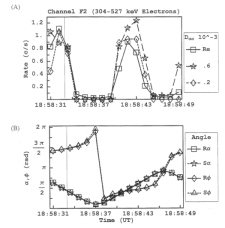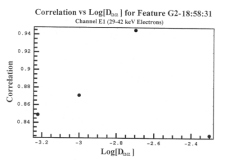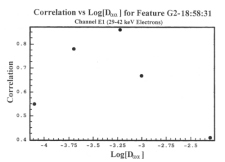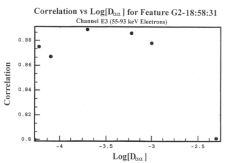Investigation of the Magnetosphere of Ganymede with Galileo's Energetic Particle Detector
Ph.D. dissertation by Shawn M. Stone, University of Kansas,
1999.
Copyright 1999 by Shawn M. Stone. Used with permission.
6.3.2 Feature G2-18:58:31 (continued)
Figures 6.94 through 6.97 show the results for model M2 channels E3 and F2. It can be seen that as the magnitude of the scattering coefficient is reduced, the features go from filled in to fitting. Model M2 seems to fit the features better in a more consistent manner than model M1. The correlations with the real data for model M2 are shown in Figure 6.98 (for E1), Figure 6.99 (for E3), and Figure 6.100 (for F2). The correlations with the real data for model M1 are shown in Figure 6.101 (for E1), Figure 6.102 (for E3), and Figure 6.103 (for F2).
 |
Figure 6.94 (A) Simulated M2 and real (Re) rate profile for feature G2-18:58:31 of Channel E3 normalized to 90º of pitch. The simulated runs are done in extended bounce mode with scattering included. (B) The pitch and phase angles are computed from the look direction of the EPD detector and the appropriate magnetic field vector R for real and S for simulated. |
 |
Figure 6.95 (A) Simulated M2 and real (Re) rate profile for feature G2-18:58:31 of Channel E3 normalized to 90º of pitch. The simulated runs are done in extended bounce mode with scattering included. (B) The pitch and phase angles are computed from the look direction of the EPD detector and the appropriate magnetic field vector R for real and S for simulated. |
 |
Figure 6.96 (A) Simulated M2 and real (Re) rate profile for feature G2-18:58:31 of Channel F2 normalized to 90º of pitch. The simulated runs are done in extended bounce mode with scattering included. (B) The pitch and phase angles are computed from the look direction of the EPD detector and the appropriate magnetic field vector R for real and S for simulated. |
 |
Figure 6.97 (A) Simulated M2 and real (Re) rate profile for feature G2-18:58:31 of Channel F2 normalized to 90º of pitch. The simulated runs are done in extended bounce mode with scattering included. (B) The pitch and phase angles are computed from the look direction of the EPD detector and the appropriate magnetic field vector R for real and S for simulated. |
 |
Figure 6.98 Correlation of feature G2-18:58:31 with simulated M2 E1 data for varying values of Daa. This graph shows that the scattering coefficient with the highest correlation is Daa=2 x 10-3 s. |
 |
Figure 6.99 Correlation of feature G2-18:58:31 with simulated M2 E3 data for varying values of Daa. This graph shows that the scattering coefficient with the highest correlation is Daa=1 x 10-3 s. |
 |
Figure 6.100 Correlation of feature G2-18:58:31 with simulated M2 F2 data for varying values of Daa. This graph shows that the scattering coefficient with the highest correlation is Daa=2 x 10-4 s. |
 |
Figure 6.101 Correlation of feature G2-18:58:31 with simulated M1 E1 data for varying values of Daa. This graph shows that the scattering coefficient with the highest correlation is Daa=6 x 10-4 s. |
 |
Figure 6.102 Correlation of feature G2-18:58:31 with simulated M1 E3 data for varying values of Daa. This graph shows that the scattering coefficient with the highest correlation is Daa=2 x 10-4 s. |
 |
Figure 6.103 Correlation of feature G2-18:58:31 with simulated M1 F2 data for varying values of Daa. This graph shows that the scattering coefficient with the highest correlation is Daa=1 x 10-4 s. |
Next: 6.4 Outbound Results
Return to dissertation table of contents page.
Return to main
Galileo Table of Contents Page.
Return to Fundamental
Technologies Home Page.
Updated 8/23/19, Cameron Crane
QUICK FACTS
Mission Duration: Galileo was planned to have a mission duration of around 8 years, but was kept in operation for 13 years, 11 months, and 3 days, until it was destroyed in a controlled impact with Jupiter on September 21, 2003.
Destination: Galileo's destination was Jupiter and its moons, which it orbitted for 7 years, 9 months, and 13 days.



